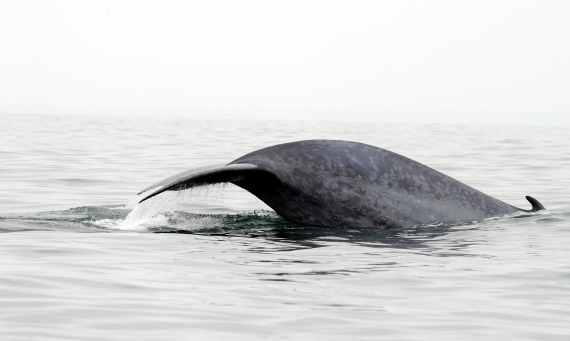
As if behemoth ballerinas, blue whales pirouette before lunging at their prey, a strategy that may help the giants ambush krill from below.
"This behavior probably improves the whales' chances to engulf the most krill possible," said study co-author Ari Friedlaender, a marine biologist at Duke University.
The new findings, detailed today (Nov. 27) in the journal Biology Letters, may shed light on how the enigmatic creatures hunt and devour their shrimplike prey.
Hungry giants
The blue whale, the largest creature to ever live, can span up to 98 feet (30 meters) long and weigh up to 200 tons (180 metric tons). This creature the size of a submarine uses its bristly, comblike teeth, or baleen, to filter tiny crustaceans called krill from the water. Last century, Antarctic whalers who opened up the massive bellies of blue whales often found up to 2,000 pounds (907 kilograms) of krill, though the sea giants probably don't eat that much every day, Friedlaender told LiveScience.
Because krill cluster in massive swarms, "they're perfect food for something like a baleen whale that wants to engulf a big amount of something at one time," Friedlaender told LiveScience.
But while the marine mammals' diet is well-known, how they find their prey remains a mystery.
Sign up for the Live Science daily newsletter now
Get the world’s most fascinating discoveries delivered straight to your inbox.
To understand these foraging behaviors, Friedlaender and his colleagues attached motion sensors to the backs of 22 blue whales using suction cups. They also attached a critter cam to one individual, which showed the ocean and part of the whale's head from the animal's point of view. [See Video as a Blue Whale Dives for Krill]
When Friedlaender's team analyzed the data, they found something completely unexpected.
The sensors, which captured several hours of data from each whale, revealed half of the whales doing full, 360-degree turns. Many of these underwater twirls occurred as whales dove for prey.
A blue whale typically spots a dense krill swarm by the dark patch it leaves on the water's surface as seen from below. Once the swarm is spotted, the whale surges upward toward the dark spot and opens its mouth to engulf the krill in one big gulp. But sometimes, it also whirls around as it performs this lunge.
"As it opens its mouth it begins to roll over. It's a very energetically costly thing to do — it's like a parachute opening and the whale slows down considerably," Friedlaender said.
The stealthy strategy may allow whales to anticipate the krills' escape route and adjust before the krill have a chance to cluster together out of reach, he added.
Because one dense krill patch could provide a day's worth of food, it makes sense to perfect their hunting strategies, even if it takes a lot of energy, the researchers write in the journal article.
Whales also turned just before and between dives, suggesting the rotations help the cetaceans scope out the location of prey.
"As in all cetaceans, the eyes are positioned laterally, and thus rolling the body should enhance panoramic vision in multiple dimensions," the researchers write.
Editor's Note: This article has been updated to correct the journal in which the study appeared: it was Biology Letters, not Current Biology.
Follow LiveScience on Twitter @livescience. We're also on Facebook & Google+.

Tia is the managing editor and was previously a senior writer for Live Science. Her work has appeared in Scientific American, Wired.com and other outlets. She holds a master's degree in bioengineering from the University of Washington, a graduate certificate in science writing from UC Santa Cruz and a bachelor's degree in mechanical engineering from the University of Texas at Austin. Tia was part of a team at the Milwaukee Journal Sentinel that published the Empty Cradles series on preterm births, which won multiple awards, including the 2012 Casey Medal for Meritorious Journalism.










